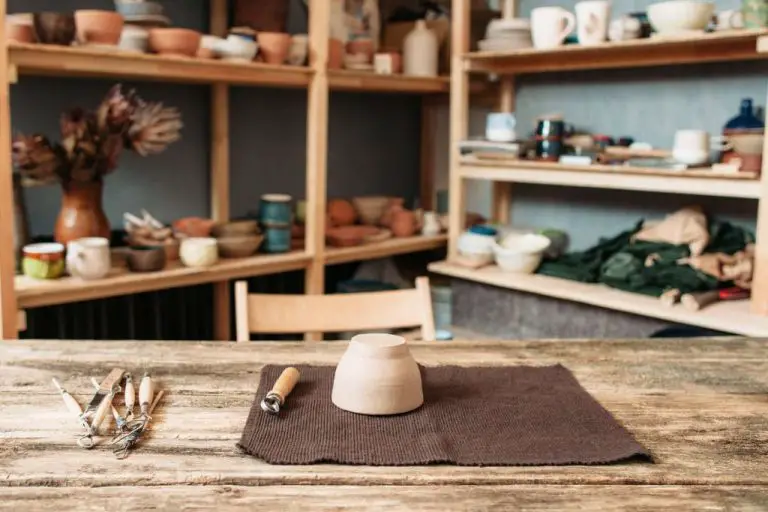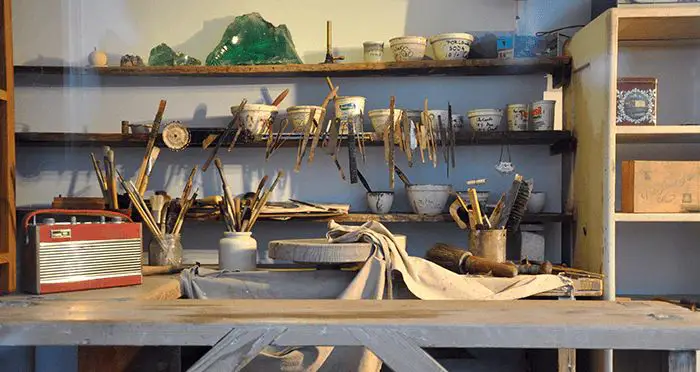Do Silicone Molds Work For Clay?
Introducing Silicone Molds for Clay
Silicone molds are a popular option for shaping and detailing polymer clay, air-dry clay, and some ceramic clays. Silicone has a slippery, non-stick surface that allows easy release of the clay after baking or drying. Using a silicone mold eliminates the need to add mold release sprays or powders.
Silicone molds offer several key benefits for working with clay:
- Non-stick surface for easy clay release
- Flexibility that allows molding intricate shapes and textures
- Heat resistance that enables baking clay directly in the mold
- Reusability for repeated projects
- Crisp reproduction of mold details
The most commonly used clay types with silicone molds are polymer clay, air-dry clay, and cold porcelain clay. Polymer clays like Sculpey and Fimo soften during baking for easy unmolding. Air-dry clays like DAS and Crayola Model Magic cure at room temperature in the mold. Cold porcelain is a non-toxic, non-drying modeling clay that will not stick in silicone molds.
How Silicone Molds Work for Clay
Silicone molds are made from silicone rubber, which has unique properties that make it ideal for molding clay. Silicone is composed of silicon, oxygen, carbon, and hydrogen. It is an elastic polymer, which means it has a molecular structure that allows it to bend and flex repeatedly without breaking down. Here are some key properties of silicone that enable it to work well as a mold material for clay:
- Flexible – Silicone molds are extremely flexible and bend easily without permanently deforming. This allows the mold to be pushed and stretched to release molded clay pieces.
- Non-Stick – Silicone has a naturally non-stick surface that prevents clay from adhering to the mold. This makes detaching the finished piece easier.
- Heat-Resistant – Silicone can withstand the high temperatures needed for curing polymer clay without melting or distorting in shape.
- Durable – Silicone molds are very durable and can last through many uses if properly cared for. The material will not degrade or tear easily.
The molding process with silicone molds is straightforward. First the raw clay is conditioned, then pressed into the mold cavity. Air pockets can be eliminated by pressing the back of the mold while filling it. Once fully pressed into the detailed shape, excess clay is trimmed off and the mold is flexed to release the molded clay piece. The finished piece can then be refined, cured in an oven, and decorated as desired. Silicone allows for effortless molding and unmolding, enabling intricate clay creations.
Advantages of Silicone Molds
Silicone molds offer several key advantages that make them a top choice for working with polymer and air-dry clays:
Durability and Reusability
Silicone is an extremely durable material that can withstand repeated use without wearing out. Silicone molds can be used hundreds of times without losing their shape or detail 1. This makes them a cost-effective option compared to single-use molds.
Flexibility and Easy Release
Silicone naturally flexes and releases baked clay easily, meaning smooth unmolding and less risk of damage to delicate clay pieces 2. The flexibility also allows for easy popping out of clay shapes without exerting much force.
Detail Reproduction
Silicone captures intricate designs and details very well. When clay is pressed into the mold, even tiny patterns and textures will be cleanly imprinted. This allows for accurately recreating complex shapes and surfaces.
Variety of Shapes and Textures
Silicone molds come in a huge range of options – 3D shapes, open-face molds, tiles, and sheets. Textures like wood grain, leaves, gears, and more can be found. This variety allows endless creativity and customization for clay projects.
Disadvantages of Silicone Molds
While silicone molds offer many benefits for working with clay, there are some potential drawbacks to consider as well:
Silicone molds can be expensive, with the upfront cost being higher than some other mold materials. The cost depends on factors like the size and complexity of the mold, but they are one of the pricier mold options.
Silicone molds tend to be limited in maximum size, especially for intricate molds with a lot of undercuts and detail. The flexibility of the material makes large or complex molds prone to distortion. Molds are typically kept under 12″ for optimal results.
Silicone molds require care and maintenance for longevity. Letting clay dry and cure fully in the molds can cause tearing over time. Proper cleaning after each use is essential.
The flexibility of silicone can lead to occasional curing issues with some clay types. Some clays may not cure smoothly or capture fine mold details. Rigid clays like stoneware or porcelain may crack while curing.
Sources:
https://modelrailwayengineer.com/disadvantages-using-moulds-for-polymer-clay/
Best Clay Types for Silicone Molds
When working with silicone molds, the type of clay used is important. Some clays contain sulfur or other chemicals that can inhibit silicone curing. The best clay options for silicone molds include:
Polymer Clay
![]()
Polymer clay is an excellent choice as it is a sulfur-free modeling clay. Popular brands like Sculpey and Fimo are safe for making molds. Polymer clays require baking to harden, which makes them easy to work with and add details before molding. According to redditors, polymer clay holds fine details well for capturing all the texture in a silicone mold.
Air-Dry Clay
Air-dry clays like Crayola Model Magic are non-toxic clays that harden when exposed to air, so they don’t require baking. They can be molded once dried completely. Air-dry clays are budget-friendly and work well for basic shapes and designs. Details may not hold as precisely compared to baked clays.
Oven-Bake Clay
Clays like Sculpto-Firm and Makins clay are sulfur-free oven-bake modeling clays. They can be molded once hardened after baking. Oven-bake clays hold fine details well. According to Smooth-On, these sulfur-free clays are ideal for silicone mold making.
In summary, polymer, air-dry, and oven-bake modeling clays are good options for silicone molds. Polymer clays tend to capture the most refined details. However, air-dry and oven-bake clays work well for basic shapes and designs.
Clay Types to Avoid with Silicone
When working with silicone molds, some types of clay are not recommended. Specifically, clays that contain a lot of water or oil can cause issues.
Water-based clays like air-dry clay can be problematic in silicone molds. As the water evaporates from the clay, it can leave behind residue and stickiness on the inside of the mold 1. This can shorten the lifespan of the mold.
Similarly, oil-based clays like plasticine should also be avoided with silicone molds. The oil in the clay can leave an oily film that sticks to the mold and affects future uses 2. The oil can also break down the integrity of the silicone over time.
In summary, water-based clays and oil-based clays are not ideal for reuse in silicone molds. Their water and oil content can leave residue, create stickiness, and degrade the mold over time. Polymer clays or non-hardening clays are better suited for silicone molds.
Tips for Using Silicone Molds with Clay
When working with silicone molds and clay, there are some useful tips to ensure the best results:
Prepare the mold by spraying it lightly with a mold release like water or cornstarch to prevent sticking. Make sure the mold is clean and free of any residue from previous uses (Sculpey).
Properly condition the clay by kneading and softening it before molding. Softer, more pliable clay fills intricate molds better. Avoid overworking the clay so it doesn’t get sticky (The Blue Bottle Tree).
Press the clay into the mold in small pieces rather than one large lump. Use fingers or clay sculpting tools to firmly press the clay into all crevices and edges of the mold.
Allow adequate baking/drying time as specified for the clay type. Underbaking can cause sticking while overbaking risks scorching. Carefully follow clay manufacturer instructions.
Let the molded clay cool completely before attempting to remove it from the mold. Gently flexing the silicone can help loosen the clay for clean demolding.
Use sandpaper or files to smooth mold lines and shiny areas on the finished piece. Dust off any excess cornstarch residue.
Cleaning and Caring for Silicone Molds
Properly cleaning and storing silicone molds is important for extending their lifetime and ensuring they continue producing quality casts. Here are some tips for caring for silicone molds used with clay:
Cleaning Methods
After each use, remove any excess clay from the mold. Use a soft brush or toothpick to gently clean crevices and detailing. Avoid anything abrasive that could scratch the mold surface. To remove stubborn dried clay residue, soak the mold in warm soapy water for 10-15 minutes then scrub gently with a soft brush [1]. You can also use a small amount of rubbing alcohol applied with a cotton swab.
Proper Storage
Store silicone molds in a clean, dry place away from direct sunlight and heat, as exposure can cause the silicone to degrade over time. Avoid storing molds pressed or stacked tightly together. Lightly powdering the mold surface with corn starch can help prevent tackiness.
Extending Mold Lifetime
Take care not to stretch or warp the mold when demolding as this can lead to deformities. Limit use of mold release agents which can build up over time. With proper care between uses, quality silicone molds can last for years and hundreds of casts.
When to Replace
Look for signs of wear like tears, embedded clay particles, and deformation. Deep scratches and opacity also indicate a silicone mold may need replacement.
Creative Uses of Silicone Molds
Silicone molds open up a world of possibilities for creative projects with clay. Here are some of the most popular creative uses for silicone molds:
Jewelry
Silicone is ideal for making detailed jewelry pieces out of polymer clay. Molds allow you to easily replicate components like beads, pendants, and charms with intricate designs. According to https://thebluebottletree.com/using-silicone-molds-polymer-clay/, silicone molds work well with most polymer clay brands.
Figurines
Silicone molds shaped like animals, characters, and more let you make miniature clay figurines. These can be used for dollhouse accessories, tabletop RPG games, holiday ornaments, and decorative displays. Soft clays like polymer and air-dry clay are commonly used.
Home Decor
For home decor projects like wall plaques, coasters, and decorative boxes, silicone molds add nice detailing. Imprint designs, textures, or shapes on clay pieces before baking or air-drying. According to https://www.sculpey.com/blogs/blog/using-silicone-molds-with-polymer-clay, clays like Super Sculpey and Sculpey III work well.
Molds for Other Materials
You can make custom silicone molds from original clay pieces to reproduce designs in materials like resin, concrete, soap, and candles. Let clay fully cure before molding, then pour your preferred material. The mold flexibility helps remove cast pieces.
With so many options, silicone molds unleash creativity with clay! Add unique patterns and precision detailing to handmade projects.
Conclusion
In summary, silicone molds are an excellent choice for working with polymer clay. The flexibility and non-stick properties of silicone allow for easy demolding of clay pieces without distortion. Silicone molds can capture fine details, which get imprinted into the clay. The durability of silicone also enables repeated reuse of molds for clay.
Some key benefits of using silicone molds with polymer clay are the ability to efficiently duplicate complex designs, achieve uniformity in production, and create dimensional pieces. Silicone molds are also highly versatile, working with most types and brands of polymer clay.
Considerations when selecting molds include finding designs suited to the clay thickness and baking temperature. Properly preparing molds and using mold release can prevent sticking. With care and maintenance, quality silicone molds can serve clay artists for many projects.
Overall, silicone molds unlock creative potential with polymer clay. Combined with the sculptability of clay, detailed and customizable silicone molds enable artists to produce beautiful, professional designs and effects. Clay artists can leverage silicone molds to expand their skills and creations.



